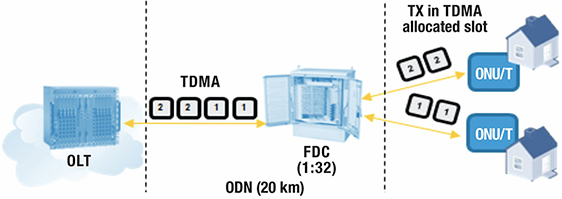The ODN Packs a Punch for Smart Cities
By Steven Harris
Many fantasize of a city that will drastically improve our quality of life. The notion of a sci-fi futuristic city sounds inviting, however, we sure do not want a city that resembles Skynet. Many desire a city that evolves with the latest technological and connectivity platforms, enabling an efficient, agile and responsive network. Smart cities leverage a provider’s infrastructure such as fiber, IoT, cloud and backhaul gateways. An agile infrastructure approach for smart cities may be the use of PONs, along with a routed fiber backbone.
PONs are traditionally used to provide FTTH services. However, as fiber offers a vast amount of bandwidth and extends deeper in an operator’s network, it becomes logical as a transport for smart cities. Given that PON is here to stay, telecommunication professionals should be re-skilling to support these technologies. A solid foundation of fiber competencies, PON operations and its many components will allow professionals to deploy services from residential to the smart city.
PONs offer a rich pipeline for the next generation of gigabit+ services. PONs are passive networks, offering significant energy cost savings, along with excellent reliability and low latency. PONs offer frame structures of 1 Gbps up to 50 Gbps (IEEE 802.3ca). This MAC multipoint network is ideal for 10G, as it has more to offer than a traditional point to point (ptp) fiber architecture. An access network for PON is referred to an optical distribution network, or ODN.
The ODN is ideal for backhauling data or delivering services for smart cities. The ODN supports the delivery of PONs like E/GPON over a tree, bus or ring topology. For a typical ODN deployment, the most popular approach to manage is a centralized single split, resembling a tree topology. Alternative topology designs are available, referred to as the distributed split and distributed tap/segmented split.
The passive components within the ODN are referred to as the PON service area (PSA). The PSA consists of fiber, the fiber distribution cabinet (FDC), and an optical splitter. The ratio for the optical split is determined by the calculated optical power budget (dBm/mW), most operators use a 1:32 for their MAC domains. There are also active PONs, using EDFAs to extend the 20 km length of a PON. The fiber within an ODN carries the DS and US wavelength signals using WDM, similar to multiple wavelengths found inside an HFC network. However, an ODN is a dense digital fiber architecture, as opposed to a coarse analog fiber HFC. Operators may additionally use dense WDM, supporting an overlay within the PON, along with coexistence of multiple varieties of PONs. The optical splitter divides the DS signal from the operator’s facility, allowing connectivity for multiple customers sharing a single wavelength (e.g., 1490 nm). The physical layer of the DS signal utilizes centrally coordinated TDM broadcasts via timeslot assignments for each customer. In the U.S., TDMA allows multiple customers to communicate with the provider over another wavelength (e.g., 1310 nm).
To communicate these signals, along with L2/L3 signals, an OLT is employed. At the operator’s facility, the OLT connects to the ODN. There is an alternative design using a remote OLT (R-OLT), outside the facility via a L2/L3 connection. A R-OLT may be strand mounted using an SCTE·ISBE GAP enclosure. At the customer premises the ODN connects to an ONU/EPON or an ONT/GPON. The ONU and the ONT function to convert optical to RF (Ethernet/Wi-Fi).
In conclusion the ODN is the heart of a PON design. Becoming familiar with its technology, various components and signal flow will solidify your role in the telecommunication industry, along with smart cities. Interested in learning more about becoming a PON expert, visit SCTE.org/BFI.
—

Figure 1. Optical distribution network topologies (centralized/tree, bus and ring)

Figure 2. Multiple access PON communication in the upstream
 Steven Harris
Steven Harris
Executive Director, Technical Sales, Learning & Development
SCTE•ISBE
sharris@scte.org
Steve is an international SME and thought leader, and the executive director of education and business development for SCTE·ISBE. He is responsible for overseeing the architecture and evolution of educational programs, credentialing, and customized career progressions, as well as business development and partnerships. His team is responsible for an education library that is now 900+ modules, designed to drive business results. With more than 30 years in education, he has taught much of the content of the library, with a dynamic approach to the delivery of highly complex topics.
Shutterstock



